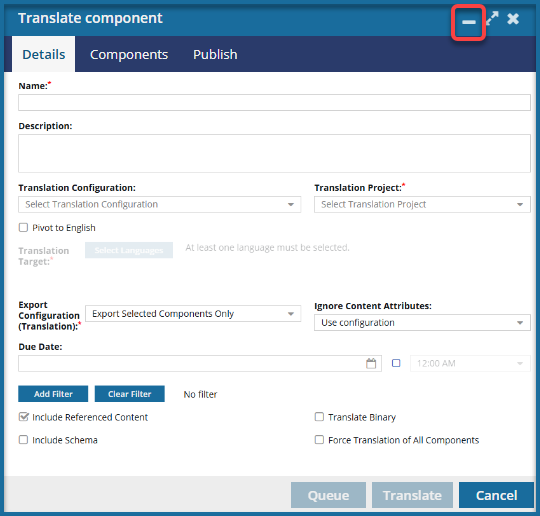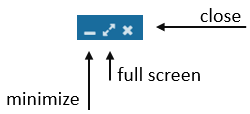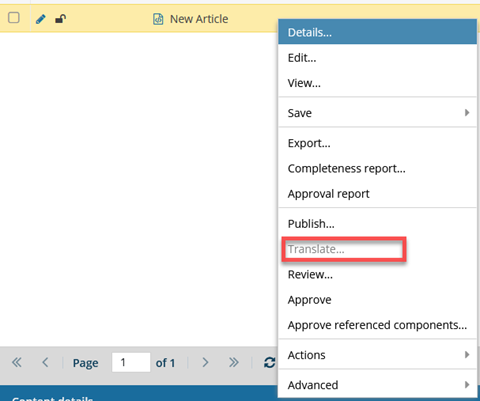Translate Components
For each component or group of components you want translated, you must select the languages and how you want to export the files. Then Inspire creates a folder for each language you've selected. In these language folders are copies of the component files you want translated.
 You must have permission to be a translation coordinator or be an administrator before you can send a component to translation or manage a translation job.
You must have permission to be a translation coordinator or be an administrator before you can send a component to translation or manage a translation job.
To translate content in Inspire, you can do any of the following:
- Understand the translation process. Translating content can be an automated or manual process.
 Understand the translation process.
Understand the translation process. - Read FAQs. Frequently asked questions give you answers about translation restrictions and why a job might fail.
- Send components to translation. You can select one or more components to translate and then create the job by completing the required details.
Before you create the job, make sure you know if you have any special requirements.
- Check component completeness: Before you publish a component or send it for translation, you can view a report to see if there are any errors or problems. By default, the completeness report checks a component for:
- Filtering of conditional text
- Approval state
- Electronic signatures,
- States (Lock, Invalid)
- Invalid XML
- Comments or track changes
- Translation status (If it has been sent to translation previously, if the translation has been completed or if it still needs to be translated).
- Translate a foreign language to English first: If you create content in a language other than English, you can configure Inspire to translate your content to English first. Then Inspire automatically creates a job to translate the English source to the target language.
- Queue a translation job: Before you start a job, you can put it on hold. Inspire prepares the files for translation and locks the files. No translation request is sent to an integrated application yet.
- Request a quote for a translation job: For a Queued translation job, you can use an option to send a request for a quote if an administrator has configured it.
 Enable quotes for translation projects
Enable quotes for translation projects You are notified when a quote is returned from GlobalLink Enterprise and can review the quote. All quotes must be approved before the translation work can begin. You can't reject a quote, approve some quotes and not others, or cancel a quote request. You can manage quotes in GlobalLink Enterprise or cancel the entire translation job in Inspire.
- Submit a queued translation job: If you aren't using quotes, to start the manual translation work or work with a vendor, you must Submit the job when you are ready.
- Request a quote for a translation job: For a Queued translation job, you can use an option to send a request for a quote if an administrator has configured it.
- Create separate translation submissions: When you select multiple files to send to translation at the same time, you can choose to create one job that contains multiple files or a separate translation submission job for each file. For example, if you select five maps and go to the Selected Components panel, you can select the Translation option and you can specify if you want to send them all in one translation job or split them up

 Need to keep the Translate component screen open?
Need to keep the Translate component screen open?When you open the Translate component screen to fill out the details for a translation request, you can now minimize this screen to go and check other Inspire screens for information.

- The Translate component screen now functions as a secondary window that appears on top of the Inspire dashboard or any other module you're working in.
- You can only have one Translate component screen open at a time.

- In the Translate component screen, you can use
 the minimize control to temporarily hide the screen.
the minimize control to temporarily hide the screen.
- You see a blue title bar with the name of the Translate component screen in the bottom right corner of the Inspire app.

- To restore the minimized screen, click
 the minimize icon again.
the minimize icon again.

- Check component completeness: Before you publish a component or send it for translation, you can view a report to see if there are any errors or problems. By default, the completeness report checks a component for:
- Manage translation jobs. The translation work for most jobs are automatically started when you create the job. Some jobs may have been prepared but put on hold until you submit them. After a translation job has been started, you can update some details. You can also check the job status and cancel or force complete the work. For a history of work done, you can generate reports to show you all the details in one place.
- Submit a queued translation job
- Check the status of a translation job
- Update translation details
- Cancel part or all of a translation
- Force a translation job to be Completed
- Generate reports on translation jobs

 Be aware of restrictions and exclusions that can be applied to components!
Be aware of restrictions and exclusions that can be applied to components!
- Optional feature restriction for Approval. By default, a translation coordinator can select any unlocked component and send it to translation. However, an administrator can restrict the ability to send a component to translation unless it has first been approved.
- If an administrator sets the optional TranslationApprovedOnly feature to true and enables it:
- In the Components browser, when using the right-click or
 Options menu, the Translate option cannot be selected if the component is not approved.
Options menu, the Translate option cannot be selected if the component is not approved.
- If the topic is approved, for example a map, but the references are not, the coordinator sees errors for those components that are not approved.
- If the topic is approved, but the references are not, the translation job can't be created until one of the following occurs:
- The TranslationApprovedOnly feature is not enabled (set to false).
- The coordinator approves all referenced components.
- On the Translate component screen, the coordinator clears the Include referenced components option.
- In the Components browser, when using the right-click or
- If an administrator sets the optional TranslationApprovedOnly feature to true and enables it:
- Components can be excluded by a tag. If a user doesn't want a file sent to translation, they can use a component tag to tell other users that translation isn't required. This tag also tells Inspire not to make language copies of it or to send it to translation.
- Inspire provides the pre-defined tag TranslateNotRequired.
- If you apply the TranslateNotRequired tag to a component:
- You see the component marked with
 a tag in the Components browser.
a tag in the Components browser. - Translation coordinators can still add the tagged component to a translation job.
- Inspire makes sure that the component isn't sent with any new translation jobs.
- If you use this tag and the component is an XML file or a binary component such as an image or PDF file, copies of the files aren't created for translation.
- Any links in the component continue to use references in the original language.
- You see the component marked with